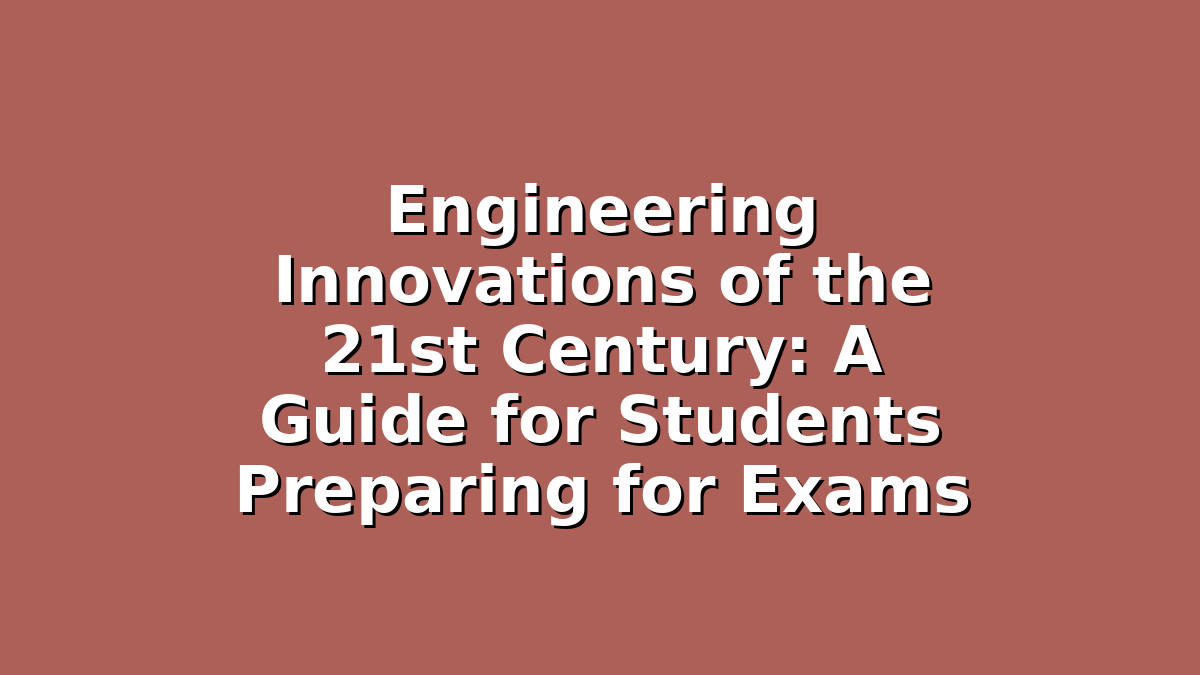The 21st century has witnessed remarkable advancements in engineering that continue to shape the world around us. From groundbreaking technologies that improve everyday life to revolutionary designs that tackle global challenges, engineering innovations are central to progress. For students preparing for exams, especially those studying science, technology, engineering, and mathematics (STEM) subjects, understanding these innovations is not only inspiring but can also provide useful context and examples to boost exam performance. This article explores three major engineering innovations of the 21st century and offers practical study tips to help you grasp these concepts effectively and confidently.
1. Renewable Energy Technologies: Powering a Sustainable Future
One of the biggest engineering breakthroughs in recent decades is the rapid advancement of renewable energy technologies. Engineers have developed innovative ways to harness natural resources like sunlight, wind, and water to generate electricity sustainably. Solar panels have become more efficient and affordable, wind turbines are growing in size and power, and hydroelectric systems are being optimized for minimal environmental impact.
Why It Matters for Students: Renewable energy is a frequent topic in exams related to environmental science, physics, and engineering. Knowing about these technologies can give you an edge when answering questions about green energy and sustainability.
Study Tip: Create summary notes that include key concepts such as photovoltaic cells, wind turbine mechanics, and energy conversion efficiency. Use diagrams to visualize how these systems work. Additionally, try to relate these topics to real-world examples you encounter in news or documentaries—connecting theory to practical applications enhances memory retention.
Exam Strategy: When answering exam questions, include specific examples of engineering innovations like the Tesla solar roof or offshore wind farms. This shows a deeper understanding and can help you earn extra marks for application and analysis.
2. Robotics and Automation: Transforming Industries and Daily Life
Robotics and automation have evolved dramatically thanks to advances in artificial intelligence (AI), machine learning, and sensor technologies. From self-driving cars to automated manufacturing lines, engineering innovations in robotics are revolutionizing how industries operate and how people interact with machines.
Why It Matters for Students: Robotics is a multidisciplinary field involving mechanical engineering, computer science, and electronics—all common subjects in STEM curricula. Understanding how robots are designed and programmed can help you tackle questions related to control systems, algorithms, and technological impacts.
Study Tip: Break down the study material into focused sections: mechanical design, sensor integration, and AI programming basics. Use online resources such as simulation software or coding platforms that allow you to experiment with simple robotic concepts. Hands-on learning reinforces theoretical knowledge and boosts exam confidence.
Exam Strategy: When discussing robotics in essays or problem-solving questions, highlight the societal benefits and challenges, such as improved efficiency, job displacement concerns, and ethical considerations. Providing a balanced viewpoint demonstrates critical thinking.
3. Smart Infrastructure: Building the Cities of Tomorrow
The concept of “smart cities” is no longer futuristic—it is happening now. Engineering innovations in smart infrastructure use the Internet of Things (IoT), big data analytics, and sustainable materials to create urban environments that are safer, more efficient, and environmentally friendly. Examples include intelligent traffic management systems, smart grids for electricity, and eco-friendly building designs.
Why It Matters for Students: Smart infrastructure intersects with civil engineering, environmental science, and information technology. It’s a rich topic for exams focused on urban development, sustainability, and engineering ethics.
Study Tip: Develop a mind map to connect different components of smart infrastructure—transportation, energy, water management, and waste systems. Group study sessions focused on case studies of cities implementing smart solutions (like Singapore or Copenhagen) can help you understand practical aspects. Discussing these topics with peers or teachers can also reveal new insights.
Exam Strategy: Use case studies to support your answers, showing how smart infrastructure helps solve real-world problems such as traffic congestion or energy wastage. Incorporate terminology like “sensor networks,” “data-driven decision making,” and “sustainable urban planning” to demonstrate your grasp of the subject.
Conclusion: Embrace Innovation and Study Smart
The engineering innovations of the 21st century represent exciting opportunities and challenges for society. As a student preparing for exams, delving into these topics can not only deepen your understanding of core STEM subjects but also inspire you to think creatively about future solutions. To succeed, focus on active learning techniques such as summarizing, visualizing, and applying concepts to real-world scenarios. Remember to pace your study, take breaks, and discuss ideas with others to solidify your knowledge.
Stay curious, stay motivated, and approach your exams with confidence—understanding the engineering marvels shaping our world today will prepare you well for the challenges of tomorrow.

Responses